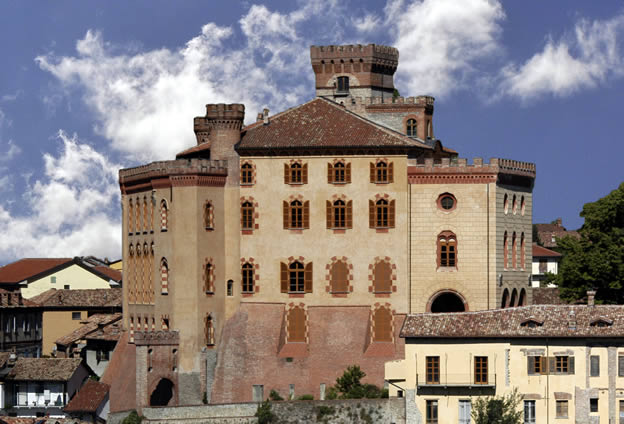Castles » Castle of Barolo and its Wine Museum

In a small town of the Langhe, the Barolo Castle has a centuries-long history and an international museum dedicated to the world of wine. There is perhaps no better place to have the WiMu - Wine Museum - than in the land where Barolo is made, to tell the story and history of such a complex product that comes from many civilizations and whose history goes back millenia.
The first documentation of a fortification in the area is from the 10th century; traces of this ancient structure are still visible today in the great tower and the lower section of the eastern tower. Around 1250, the property was taken over by the Falletti family and profoundly transformed with the passing of the years. The castle was reconstructed by Giacomo and Manfredo Falletti after being gravely damaged in the wars of the 16th century. Its resulting new facade remained intact until the death of Juliette Colbert, the last Marchesa of the Falletti family, better known as Giulia of Barolo. In the 1800s the castle was the country house of the Falletti family. Among noted guests was the writer and patriot Silvio Pellico, who is linked to the family professionally as the library curate, and also out of friendship.
According to the wishes of the Marchesa Giulia, upon her death in 1864 the castle became established as the Opera Pia Barolo: an ethical foundation charged with administrating the family fortune in case of the absence of an heir. It was this organization that chose the Castle as the seat of the Barolo College, a scholastic institution that gives the opportunity for young people in the area to study, including those less affluent. Study grants were created for such deserving students, and the castle was profoundly transformed in its role of housing the College.
In 1970, after a period of abandonment, the Castle was purchased by the Township of Barolo with the underwriting of generous citizens, local companies and stores, and alumni of the College. The following restoration works were supported by the Town of Barolo, the Province of Cuneo, and the Piedmont Region, allowing the castle to open several rooms for visitors with the additional help of volunteers.
Beginning in 2010, the Falletti Castle has been the seat of the WiMu, or the Wine Museum of Barolo. It is the work of François Confino, the planner of numerous museum displays throughout the world, including the National Cinema Museum in Turin. The Wine Museum includes a multisensory and interactive course that is entertaining and encourages active participation.
The course leads through five floors of the Castle and enters the realms of science, sensory analysis, and poetry. It is a total immersion into the world of wine, a sensation that is reenforced by the final stopping point in the heart of the Falletti castle, the winery.
On the third floor, natural elements connected to wine are addressed, like the heat of the sun, the phases of the moon, the quality of the soil, and the work of man that follows the months and seasons. The second floor tells of the history shared by man and wine through art, cuisine, music, literature, and film. The first floor is a step back in time to the Falletti family, with original furnishings on display. It is in honor of the last of the Falletti Marchesi, of Carlo Tancredi and his wife Giulia and the fundamental roles they played in the "creation" of Barolo wine. The below-ground first floor is in memory of the Barolo College and is the seat of the Temple of Wine Tourism, a multifunctional space for events and tastings.
Finally, after traversing the history of wine, visitors arrive in the Regional Enoteca of Barolo in the old cellars of the family. It is a representation of the eleven Townships that produce Barolo, the "king of wines".
Calendar
Information
Barolo & Castles Foundation
Piazza Falletti - 12060 Barolo (CN)
Tel. +39 0173 38 66 97
Fax +39 0173 38 07 14
E-mail info@barolofoundation.it

